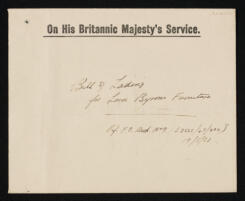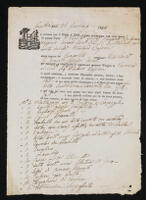Personal material of A. S. F. Gow is catalogued under (A): this includes early biographical material he compiled for his nephew Sir Michael Gow, two photograph albums, and correspondence, particularly letters (1907-1920) from William Ridgeway. There is also a handwritten biography, perhaps by Gow, of Cyril Mowbray Wells with other material relating to Wells.
Academic papers, (B), include notes on classical texts, (?1928-1951) some for lectures given by Gow, and items found with the notes, as well as part of Gow's dissertation for a Fellowship at Trinity in 1911.
(C) comprises articles by Gow,"A Cambridge Seal Box of the Seventeenth Century" (1934); "Sir Stephen Gaselee, 1882-1943 - a memoir" (1944), with related material including correspondence, press clippings and so on. (E) consists of items removed from the printed books left by Gow to Trinity College Library (now catalogued under the shelfmark GOW), including correspondence, photographs, press clippings and reviews.
Material related to A. E. Housman (F) includes Gow's "A. E. Housman - a biographical sketch" (1936), along with related items such as corrections, reviews (1936-1938) and correspondence (1936-1963); a letter to J. W. Mackail by Housman, 25 Aug 1922, with a draft copy of his "Last Poems" and comments on it, and portrait sketches of Housman, some inscribed to him by William Rothenstein. There are also newspaper reviews of Housman's inaugural lecture as Professor of Latin at University College (1892, published in 1937) and of his edition of Manilius (1938). Items relating to Housman removed from printed books left by Gow to the Library also fall under this class; several of these are letters from the authors of books on Housman to Gow, such as Laurence Housman, Percy Withers, John Carter and Henry Maas.
Items related to academic societies and institutions fall under the (G) class: reports by the Society for the Promotion of Hellenic Studies (1899-1904) and the British School at Rome (1904-1919); accounts of excavations in Cyprus from the Journal of Hellenic Studies (1887-1891).
Finally, there are six bound volumes with Gow's bookplate (H) containing transcripts of Housman's lectures. Five are typescript: three transcripts of Housman's notes now in Cambridge University Library, "The Application of Thought to Textual Criticism" (containing note of thanks to Gow from 'B[ertram] G[oulding] B[rown]), "Ovid, Heroides I-IV" and "Ovid, Heroides VI-XII" (with additional MS notes by Gow); "Horace, Odes I-III" (transcript of notes taken at Housman's lectures by S. L. Franklyn in 1932, corrections from Housman's lecture notes by B. Goulding Brown 1940-1941); "Plautus, Captivi" (transcript of Housman's notes lent to assessors in the Classical Tripos part II, 1932). The last volume contains MS lecture notes by Gow on Housman's "The Application of Thought to Textual Criticism" (1292), "Notes on Martial", and an index; loose inside, a printed sheet of extracts from Manilius', with M. S. additions in pencil, and M.S. notes by Housman.
Gow, Andrew Sydenham Farrar (1886-1978), classical scholar

